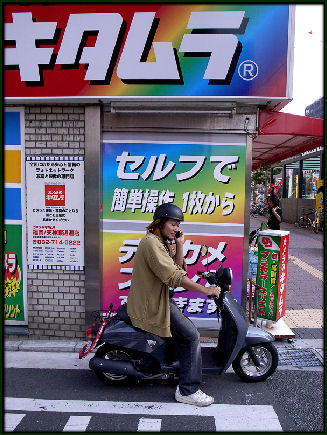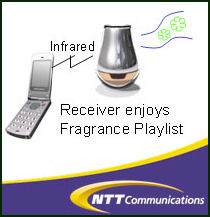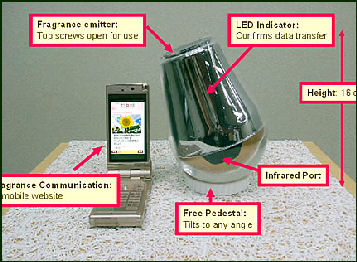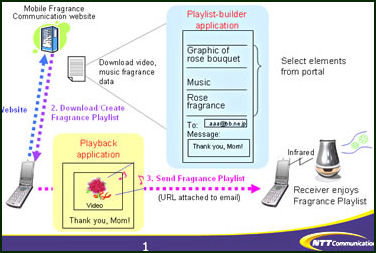USES OF CELL PHONE IN JAPAN

Japanese mobile phones are a gadget lover’s dream. They double as credit cards. They can display digital TV broadcasts. Some are even fitted with solar cells.Cell phones in Japan can be used to look up bus and train schedules, reserve tickets, shop for apartments to rent, conduct personal banking, buy and cell stock, send graphics, check the latest Sumo results, down load horoscopes, pornography and jokes of the day, check pop music charts and see what is on at local theaters, museums and concert halls.
Females between 10 and 19 spend an average of 99 minutes a day accessing the Internet with their cell phones. The national average for that is 18 minutes.
Japan leads the world in multi-function cell phones, where handsets are available that double as televisions, remotes or subway passes, and can be used to buy sodas and beer from vending machines or conduct banking. NTT Docomo and Mizuho have worked out a system to make cash transfers from one bank account to another by cell phone.
Japanese seemed to be more fond of sending e-mails, messages and playing games than talking on their cell phones. On subways it often seems like every hand has a phone flipped open. Teenagers listen to music, read manga, and surf the Internet. Girls stop in restrooms to send progress reports about dates to their friends. Poets and musicians write down thoughts that pop into their minds. Young kids are e-mailed their parents, asking them where they are.
Messages are sent with fast flaying thumbs. Some Japanese spent so much time entering messages with their thumbs they have started using their thumbs to point at things and ring doorbells. Young people who grew up playing video games and matured using cell phone developed thumbs that are stronger and more muscular that those of older people. Some can peck out 100 Chinese characters (the equivalent of 100 words) a minute with just their thumbs.
Many use their cell phones to tap to into service that send messages about bargain prices of products they want. Many of the shoppers who use the tips to snap up cosmetics, clothes and even food. Sales using cell phones jumped from ¥58.6 billion in 2003 to ¥110 billion in 2004.
Gree is an operator of hugely popular free cell phone games. It began offering games in May 2007 and had 18.43 million subscribers as of the end of March 2010. According to Forbes magazine, 33-year-old Gree President Yoshikazu Tanaka was worth $1.4 billion in 2010, making him one of Japan’s 40 richest people.
Links in this Website: MEDIA, RADIO, NEWSPAPERS AND TELEVISION IN JAPAN Factsanddetails.com/Japan ; TELEVISION PROGRAMS IN JAPAN Factsanddetails.com/Japan ; CHILDREN’s TELEVISION SHOWS IN JAPAN Factsanddetails.com/Japan ; INTERNET IN JAPAN Factsanddetails.com/Japan ; COMMUNICATIONS IN JAPAN Factsanddetails.com/Japan ; CELL PHONES IN JAPAN Factsanddetails.com/Japan ; USES OF CELL PHONES IN JAPAN Factsanddetails.com/Japan ;
Good Websites and Sources: Wikipedia article on Japan’s Cell Phone Culture Wikipedia ; Good Photos at Japan-Photo Archive japan-photo.de ; Academic article on Cell Phones and Japan’s Youth itofisher.com ; Japan Times article on Cell Phone Culture japantimes.co.jp ; Personal, Portable, Pedestrian /mitpress.mit.edu ; 2009 New York Times article on Why Japan’s Smart Phones Have Not Gone Global nytimes.com ;Cool Japanese Cell Phones crunchgear.com/ ; Ministry of Iternal Affairs and Telecommunications soumu.go.jp ; Statistical Handbook of Japan Informatin and Communications Section stat.go.jp/english/data/handbook ; 2010 Edition stat.go.jp/english/data/nenkan ; News stat.go.jp
Cell Phone Companies: Docomo nttdocomo.com ; Softbank mb.softbank.jp/en ; AU by KDDI au.kddi.com/english ; Cell Phone Novels: Mobile Phone Novel handyroman.net ; More on Cell Phone Novels futureofthebook.org ; New York Times article on Cell Phone Novels nytimes.com
Cell Phones and Social Networking in Japan
Japanese can use their cell phones to read the news and update their blogs and diaries. Mixi is a popular Facebook-like social networking site used by cell phone users. Yohei Harada, a cultural researcher in Japan told the Washington Post , young people “have become so reliant. If they have a paper due, they’ll write the paper on their cell phones, send it to their computer, cut and paste it, and send it on.”
Many sociologist see cell phones as devices that expands one’s social horizons rather than making people more isolated. Liza Mundy wrote in the Washington Post, “The phones enhance friendship by providing and a ensuring stable of peer support on standby. Calls and texting can supplement face-to-face encounters with side-by-side ones: relationships in which friends are apart, but still have a sense of being together, like a married d couple sitting companionably in the same room.”
One Japanese female cell phone user told Mundy, “If you are walking and see something strange or beautiful, it’s fine to enjoy it by yourself , but it’s even better to message a friend.” Another you girl who send and receives about 100 messages a day said, “Everybody has their cell phone in their hands, so you can always send a message to someone to let them know that you’re thinking of them.” That way she said, “even when you’re not together, you can feel together.”
Privacy, Trust and Facebook in Japan
Japanese society has recently been increasingly keen on protecting individual privacy, according to an article in the Yomiuri Shimbun. After the full enforcement of the Personal Information Protection Law in 2005, phone numbers were removed from students' name lists at schools. Local welfare commissioners, who visit homes of the elderly and other people who need assistance, had trouble obtaining information. [Source: Yomiuri Shimbun, January 11, 2011]
"It's time to rethink excessive protection of personal information," said Kansai University Prof. Yuki Yasuda, who specializes in social network analysis. "By disclosing personal information, it will be easier for people to obtain the trust of others, which enables them to moderately connect with each other. After the March 11 disaster, it has become a trend for people to attach more emphasis on such bonds," she added. Yasuda believes social networking services such as Facebook that require users to register with their real name are a sign that people want to connect with each other from a distance that is not too far and not too close.
According to the Tokyo-based research company NetRatings Japan Inc., the number of visits from personal computers to Facebook in Japan reached about 11.3 million in October, about four times larger than the same period last year. Yasuda herself has a Facebook account. "Social network services disclose relationships of users to others. Making human relationships visible to others leads to mutual trust," Yasuda said. "For these reasons, young people think it's better to disclose personal information than to hide it," Yasuda said.
Ketai (Cell Phone) Culture
The incredible growth of cell phone (“ keitai”) use since the early 1990s and the rapid advance in the functional capabilities of the units themselves have created a whole new medium for popular culture in Japan. For many people, from school age children to middle-aged adults, the cell phone has become an integral part of their way of life. In the pre-“ keitai “era, subway and commuter-train passengers in major cities were likely to be seen reading newspapers, books, or “ manga”. Today, however, they are more likely to be using their cell phones, not to talk’since long cell phone conversations are discouraged on public transportation — but to send email, to access the Internet (usually sites specially formatted for small cell phone screens), and to play video games. Students and young adults, most often women, sometimes carry on continuous, day-long “conversations” with one or more friends via cell phone email. [Source: Web-Japan, Ministry of Foreign Affairs, Japan]
“Starting around 2005, smartphones went on sale in Japan. In contrast to smartphones which feature functions akin to those of a computer, conventional Japanese cell phones are packed with unique features developed in isolation from other markets, which is why Japan’s cell phones are sometimes called “Galapagos “ keitai”.” Still, their sophisticated features’such as TV broadcasts, high-spec cameras, and a financial service known as a “wallet phone” (an IC chip embedded in the cell phone which can be used as electronic money or a credit card just by touching it against a special terminal) — give a lot of advantages to users. That is why so many people in Japan use both a smartphone and a traditional cell phone to make the most of the various features of each type of phone.
Cell Phones, Language and Literature

Dog ring tones Cell phones have not only revolutionized the way Japanese communicate verbally and through messages they have also revolutionized the way Japanese write. On a Japanese cell phone you type in hiragana and katakana. For kanji, rather than laboriously making the multiple-stroke characters, you type in syllables of hiragana and katakana, and the phone provides a list to choose from of kanji the user uses most frequently.
This phenomena has led to a general dumbing down of the written language. Kanji are now used less frequently and those that are used are simple and common and are ones most everyone is familiar. This partly explains why cell phones novels are so popular in Japan: they are easy to read and easy to write. With a cell phone you can read them any time and any place.
Japanese Cell Phone Novels
“ Ketai shosetsu” (“cell phone novels”) — most written by amateurs with no previous published works — became very popular in the mid 2000s in Japan. They were so popular in fact that published as real books they were four of the top five best selling book in 2007, lead by “ The Red Thread” by Mei, which sold 1.8 million copies, followed and “ Love Sky” and its sequel at No. 2 and nN. 3 by Mika , which together sold 2.6 million copies. [Source: Dana Goodyear, The New Yorker, December 22, 2008]
Many of the cell phone novels are by young women who use single name pseudonyms and refuse to reveal their true identity. Most of the novels are romance stories with episodes revolving around pregnancies, love triangles, abortion, rape and the like. Many are set in rural areas with characters that are middle or lower class Yankees (Japanese greasers). Most of the readers are young women.
The weepiest — and most popular’stories are often about women who suffer passively as tragic events happened to them. “ Love Sky” — which has been viewed more than 12 million times online and has been adapted for manga, television and a film that earned $35 million at the box office — is about girl who — like the author — is named Mika and is raped by a group of men incited by her boyfriend’s ex girlfriend and is dropped by her boyfriend after she gets pregnant with his child only to find out that he selflessly broke up with her to spare her the news that he is dying of rare disease.
Maho I-Land (Magic Island) is Japan and the world’s largest cell phone novel site, with over a million titles, all available for free. The site, which offers templates for blogs and novel sites, receives more than 3½ billion hits a month. Most of the novels are written by amateurs, some of whom write their posting on the train on their way to work and think up episodes while working at dead end jobs..
Eternal Dream
“Eternal Dream” — another popular cell phone novel — was posted on the Maho- I-Land in 2006 by a writer who used the pen name Mone. A onetime beauty school student and college drop out, Mone began writing her novel directly into her cell phone after looking at some old photo albums, while sitting around bored during g a visit to her hometown.
“ Eternal Dream” is about Saki, a high school student in a small town. One day while walking home from school she abducted by three strange men and gang raped and left by the side of the road, where she is discovered by a male schoolmate. They fall in love. The first installment was written on a whim. But after it appeared Mone received e-mails asking when the next installment was coming. As the story develops Saki finds out her father is not her father and her boyfriend drops her after she visits him in Tokyo.
” Eternal Dream” was completed in 19 days. By that times thousands of people had read it and publishers wanted to print it as a normal book. The hardback version was among the ten best-selling hardbacks in the first half of 2007.
In an interview with The New Yorker, Mone said she is mostly bitter about her success. She said she has earned about $100,000 from her writing but said the things she revealed about her family generated a number of fights. On her fame, she said, “If I were some super famous novelist, I would be running around saying, “hey, I’m a novelist.” But I’m not. I am treated as this lame chick whose written one of those awful cell novels...I’m considered a total loser for having done it.”
Mone told The New Yorker, “People say these horrible things about cell-phone novels, and I’m not sure they’re mistaken. They say we’re immature and incapable of writing a literate sentence. But I would say, so what? The fact that we’re producing at all is important.”
Deep Love and the Origin of Cell Phone Novels
The cell phone novel phenomena has been traced to a cram school teacher in the trendy Shibuya area of Tokyo who calls himself Yoshi. In 2000, he set up a Web Site and began posting his novel, “ Deep Love “,” about a 17-year-old girl who prostitutes herself to earn money for her dying boyfriend’s heart operation but in process gets AIDS from a client. As a self published book “ Deep Love” sold over 100,000 copes, and ultimately generated manga, a film, a television drama and a series of novels that sold 2.7 million copies.
Around the time that Yoshi began posting “ Deep Love” , Maho-I-land, which was founded in 1999, added templates called “Let’s Make Novels” to its site. The cell phone novel model took off in 2003, when unlimited data transmission packages for cell were introduced.
Cell Phones and Writing in Japan

hotel room
cell phone charger Cell phones have not only revolutionized the way Japanese communicate verbally and through messages they have also revolutionized the way Japanese write. On a Japanese cell phone you type in hiragana and katakana. For kanji, rather than laboriously making the multiple-stroke characters, you type in syllables of hiragana and katakana, and the phone provides a list to choose from of kanji the user uses most frequently.
This phenomena has led to a general dumbing down of the written language. Kanji are now use less frequently and those that are used are simple and common and are ones most everyone is familiar with. This partly explains why cell phones novels are so popular in Japan: they are easy to read and easy to write, and with a cell phone you can read them any time and any place.
Dana Goodyear wrote in The New Yorker, that Japanese cell phone novels are “quick and slangy, and filled with emotions and dialogue...The stories are have a tossed of, spoken feel.” One Japanese literature professor told her, “This is the average, ordinary girl talking to herself. The mumblings of her heart.”
Cell phone novels are generally written in truncated sentences with each clause given its own line which are often double spaced. One passage of “I, Girlfriend” by Kiki goes: “I’m/ Aki/ Age: 23/ Well, 24 this year/ Have a boyfriend?/ Well/ Just like everybody/ yes? Or. Kind of/ No way you don’t have a boyfriend/”
Otaku expert Kanta Ishida wrote in the Daily Yomiuri, “The protagonist’s monologue consists mostly of double-spaced phrases. At first, it’s hard to read. But once you get used to it, you begin to feel almost intoxicated, thanks to the rhythm of the piecemeal phrases, This imaginative style is unique to mobile phone displays.”
Cell Phones and Publishing in Japan
Cell phone novel have also revolutionized publishing. Technology executive Satovi Yoshida told The New Yorker, “The cell phone novel is an extreme success story of how social networks are used to build a product and launch it. Your fans support you and encourage you in the process of creating work — they help build the work. Then they buy the book to reaffirm their relationship to it in the first place.”
The cell phone novel phenomena has made Japanese publishing industry — which has been suffering of late, shrinking 20 percent in the last decade — both excited and worried. On one hand people are excited about a new forum to express oneself and make money but on other they see it as low common denominator form of writing.
Starts Publishing, one of the leaders in publishing cell phone novels, gives out the Japan Ketai Novel Award, which is worth about $20,000. The winner in 2008 was Kiki, a 23-year-old from a small town in Hokkaido for frank, chatty and vulgar “ I’m His Girl”. One passage goes: “Kids?/ Well/ twice I got knocked up/ By mistake?/ Like who asked them to get made/ I/ Don’t Like rubbers/ yeah/ For beer and cocks/ raw is best/ You know?. Kiki never went to college and got Fs in Japanese in high school. She wrote her story, she said, as an expression of love to her boyfriend whom she lives with. She has worked in a day care and is trained to take care of the elderly.
Cell Phones Advances in Japan

mobile fragrance system Cell phones in Japan are arguably the most advanced found anywhere. They have high resolution screens that produce sharp images and third generation networkz that allow use to shift through pages quickly. The only problem is in many cases Japanese phones can not be used outside of Japan.
In 2000, cell phones showed rock concerts with no sound. Still images flashed quickly so they looked almost like a video. In 2001, Kyocera introduced mobile video phones with a small digital camera on the back that allowed people to send pictures of themselves to friends with the same kind of phone. Costing $335 when it was introduces, the phone was as small and compact as other cell phones. The images though were often jiggly.
Japanese initially didn't take to the Internet on personnel computers with same enthusiasm as Americans but they quickly took to the Internet on the cell phones in a big way. In 2000, there were more than 40,000 web sites specifically designed for cell phones.
In 2001, Japan introduced the "third generation" of cell phone technology with great clarity and the ability to transmit data and video on color screens. The 3G technology made cell phones into wallet-sized PCs and portable play stations and with that came ring that sounded like the roar of a Tyrannosaurus Rex, services that allowed users to check their Pachinko reaction times and security systems that allow them to eavesdrop on their pets or check their house for possible intruders.
In the mid 2000s, Sony-Ericsson introduced Walkman cell phones that were like a cross between a cell phone, an iPod and a high resolution digital camera. Casio introduced models that were shockproof and waterproof and could be worn in the shower or on a scuba dive. Models for children had GPS so parents could figure out where they were.
Increasingly cell phones were being used as credit cards or wallets with electronic money functions called osaifu-keitai that allow users to buy things from convenience stores and vending machines and pass through subway and train gates. As of 2005 about 9 million cell phones used had the money function and 28,0000 shops nationwide accepted them. Payments is done through scanners positioned next to the cashier.
Japanese Cell Phone Cameras

mobile fragrance system In late 2000, cell phones with cameras were introduced J-Phone. They were a big hit. By 2003, it seemed like everyone had one. A few clicks allowed a person to take a picture, save it or send it as E-mail anywhere. People always had their cell phones with them so they could tale pictures anytime, anywhere and of anything they came across.
The Japanese quickly fell in love with taking pictures with their cell phones. Couples on dates took pictures of themselves. Young girls sent pictures of themselves with a flowery border to their friends. In national parks you’d see people gathered around a waterfall taking pictures with their phone rather than a camera. In the cities young people kept their phone cameras ready in case they saw a famous person or an especially cute outfit.
People came up with creative uses for their cameras. Housewives photographed shopping lists. Fish markets posted pictures and dates on frozen tuna for sushi chefs to make bids. Cosmetic companies offers quick analysis of photographed skin and hair samples. Police were given up-to-date images of stole vehicles and suspects.
Picture-oriented, cell phone matchmakers and dating services sprang up. People sent stored images of themselves and used as an alibi while they were somewhere else having an affair. Creeps used their cameras to sneak pictures under women’s skirts on crowded subways and under stairs and post immediately them on the Internet.
Japanese Cell Phone Products

mobile fragrance system By the mid 2000s, cell phone users had tired of advances and wanted devises that reflected their personality and taste. Special models with trendy designs were produced that appealed to fashion-conscious women and young people, A model for women introduced by DoCo Mo boasted an attractive oval shape and had features such as a menstrual-cycle calender and fake incoming call ring to provide an excuse to get out of a date. Phones designed for younger girls were shaped like cakes and macaroons. DoCoMo released an “earth-friendly” model made of natural fibers made from corn and the kenaf plant.
Kids like to decorate their cell phones with “puri-kura” (print club) stickers of their friends, Hello Kitty chains, and feathers and plastic flowers. Cloth pouches and snap-on plastic phone covers, available in a variety of colors and patterns, became very popular. Ring tones include choruses from enka ballads and J-pop hits, famous parts of Beethoven symphonies and theme songs from Miyazaki anime films.
Decorating one’s cell phone become a means of personal expression. “Deko” refers to the art of decorating one’s phone with glass and acrylic beads. Paper, clay and crystal beads made Austria’s Swarovski became especially popular with young women who adorned their phones with heart designs and portraits of Audrey Hepburn made of fake pearls and gems. Many are made by applying one bead at a time and cost up to $400. The two most popular designs at the Neu Neu, a shop that specializs in cell phone accessories, are the “princess” type with motifs such as crowns and roses and the “animal type” typified by a leopard-print patterns. See neuneu.com
Image Sources: 1) Ray Kinnane, 3) Doug Mann Photmann 2) 4) 5) 6) xorsyst blog
Text Sources: New York Times, Washington Post, Los Angeles Times, Daily Yomiuri, Times of London, Japan National Tourist Organization (JNTO), National Geographic, The New Yorker, Time, Newsweek, Reuters, AP, Lonely Planet Guides, Compton’s Encyclopedia and various books and other publications.
Last updated August 2012
